Jiacheng Yao
Combating Interference for Over-the-Air Federated Learning: A Statistical Approach via RIS
Jan 27, 2025Abstract:Over-the-air computation (AirComp) integrates analog communication with task-oriented computation, serving as a key enabling technique for communication-efficient federated learning (FL) over wireless networks. However, owing to its analog characteristics, AirComp-enabled FL (AirFL) is vulnerable to both unintentional and intentional interference. In this paper, we aim to attain robustness in AirComp aggregation against interference via reconfigurable intelligent surface (RIS) technology to artificially reconstruct wireless environments. Concretely, we establish performance objectives tailored for interference suppression in wireless FL systems, aiming to achieve unbiased gradient estimation and reduce its mean square error (MSE). Oriented at these objectives, we introduce the concept of phase-manipulated favorable propagation and channel hardening for AirFL, which relies on the adjustment of RIS phase shifts to realize statistical interference elimination and reduce the error variance of gradient estimation. Building upon this concept, we propose two robust aggregation schemes of power control and RIS phase shifts design, both ensuring unbiased gradient estimation in the presence of interference. Theoretical analysis of the MSE and FL convergence affirms the anti-interference capability of the proposed schemes. It is observed that computation and interference errors diminish by an order of $\mathcal{O}\left(\frac{1}{N}\right)$ where $N$ is the number of RIS elements, and the ideal convergence rate without interference can be asymptotically achieved by increasing $N$. Numerical results confirm the analytical results and validate the superior performance of the proposed schemes over existing baselines.
Lateral Movement Detection via Time-aware Subgraph Classification on Authentication Logs
Nov 15, 2024Abstract:Lateral movement is a crucial component of advanced persistent threat (APT) attacks in networks. Attackers exploit security vulnerabilities in internal networks or IoT devices, expanding their control after initial infiltration to steal sensitive data or carry out other malicious activities, posing a serious threat to system security. Existing research suggests that attackers generally employ seemingly unrelated operations to mask their malicious intentions, thereby evading existing lateral movement detection methods and hiding their intrusion traces. In this regard, we analyze host authentication log data from a graph perspective and propose a multi-scale lateral movement detection framework called LMDetect. The main workflow of this framework proceeds as follows: 1) Construct a heterogeneous multigraph from host authentication log data to strengthen the correlations among internal system entities; 2) Design a time-aware subgraph generator to extract subgraphs centered on authentication events from the heterogeneous authentication multigraph; 3) Design a multi-scale attention encoder that leverages both local and global attention to capture hidden anomalous behavior patterns in the authentication subgraphs, thereby achieving lateral movement detection. Extensive experiments on two real-world authentication log datasets demonstrate the effectiveness and superiority of our framework in detecting lateral movement behaviors.
Empowering Over-the-Air Personalized Federated Learning via RIS
Aug 22, 2024Abstract:Over-the-air computation (AirComp) integrates analog communication with task-oriented computation, serving as a key enabling technique for communication-efficient federated learning (FL) over wireless networks. However, AirComp-enabled FL (AirFL) with a single global consensus model fails to address the data heterogeneity in real-life FL scenarios with non-independent and identically distributed local datasets. In this paper, we introduce reconfigurable intelligent surface (RIS) technology to enable efficient personalized AirFL, mitigating the data heterogeneity issue. First, we achieve statistical interference elimination across different clusters in the personalized AirFL framework via RIS phase shift configuration. Then, we propose two personalized aggregation schemes involving power control and denoising factor design from the perspectives of first- and second-order moments, respectively, to enhance the FL convergence. Numerical results validate the superior performance of our proposed schemes over existing baselines.
Dual-view Aware Smart Contract Vulnerability Detection for Ethereum
Jun 29, 2024



Abstract:The wide application of Ethereum technology has brought technological innovation to traditional industries. As one of Ethereum's core applications, smart contracts utilize diverse contract codes to meet various functional needs and have gained widespread use. However, the non-tamperability of smart contracts, coupled with vulnerabilities caused by natural flaws or human errors, has brought unprecedented challenges to blockchain security. Therefore, in order to ensure the healthy development of blockchain technology and the stability of the blockchain community, it is particularly important to study the vulnerability detection techniques for smart contracts. In this paper, we propose a Dual-view Aware Smart Contract Vulnerability Detection Framework named DVDet. The framework initially converts the source code and bytecode of smart contracts into weighted graphs and control flow sequences, capturing potential risk features from these two perspectives and integrating them for analysis, ultimately achieving effective contract vulnerability detection. Comprehensive experiments on the Ethereum dataset show that our method outperforms others in detecting vulnerabilities.
A Federated Parameter Aggregation Method for Node Classification Tasks with Different Graph Network Structures
Mar 24, 2024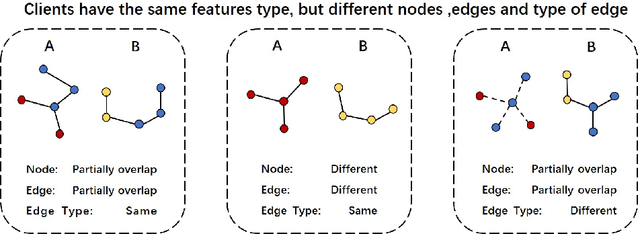

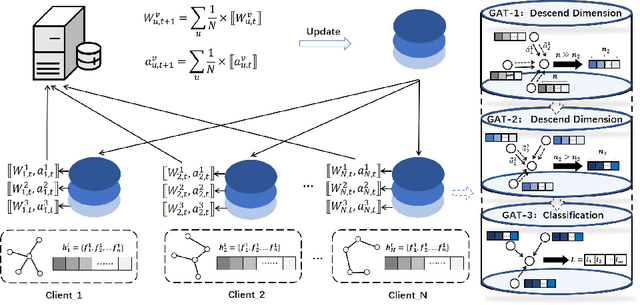
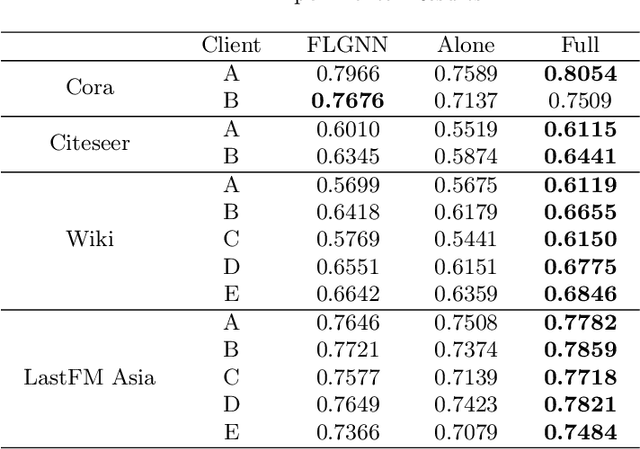
Abstract:Over the past few years, federated learning has become widely used in various classical machine learning fields because of its collaborative ability to train data from multiple sources without compromising privacy. However, in the area of graph neural networks, the nodes and network structures of graphs held by clients are different in many practical applications, and the aggregation method that directly shares model gradients cannot be directly applied to this scenario. Therefore, this work proposes a federated aggregation method FLGNN applied to various graph federation scenarios and investigates the aggregation effect of parameter sharing at each layer of the graph neural network model. The effectiveness of the federated aggregation method FLGNN is verified by experiments on real datasets. Additionally, for the privacy security of FLGNN, this paper designs membership inference attack experiments and differential privacy defense experiments. The results show that FLGNN performs good robustness, and the success rate of privacy theft is further reduced by adding differential privacy defense methods.
Digital versus Analog Transmissions for Federated Learning over Wireless Networks
Feb 15, 2024Abstract:In this paper, we quantitatively compare these two effective communication schemes, i.e., digital and analog ones, for wireless federated learning (FL) over resource-constrained networks, highlighting their essential differences as well as their respective application scenarios. We first examine both digital and analog transmission methods, together with a unified and fair comparison scheme under practical constraints. A universal convergence analysis under various imperfections is established for FL performance evaluation in wireless networks. These analytical results reveal that the fundamental difference between the two paradigms lies in whether communication and computation are jointly designed or not. The digital schemes decouple the communication design from specific FL tasks, making it difficult to support simultaneous uplink transmission of massive devices with limited bandwidth. In contrast, the analog communication allows over-the-air computation (AirComp), thus achieving efficient spectrum utilization. However, computation-oriented analog transmission reduces power efficiency, and its performance is sensitive to computational errors. Finally, numerical simulations are conducted to verify these theoretical observations.
Superimposed RIS-phase Modulation for MIMO Communications: A Novel Paradigm of Information Transfer
Aug 10, 2023Abstract:Reconfigurable intelligent surface (RIS) is regarded as an important enabling technology for the sixth-generation (6G) network. Recently, modulating information in reflection patterns of RIS, referred to as reflection modulation (RM), has been proven in theory to have the potential of achieving higher transmission rate than existing passive beamforming (PBF) schemes of RIS. To fully unlock this potential of RM, we propose a novel superimposed RIS-phase modulation (SRPM) scheme for multiple-input multiple-output (MIMO) systems, where tunable phase offsets are superimposed onto predetermined RIS phases to bear extra information messages. The proposed SRPM establishes a universal framework for RM, which retrieves various existing RM-based schemes as special cases. Moreover, the advantages and applicability of the SRPM in practice is also validated in theory by analytical characterization of its performance in terms of average bit error rate (ABER) and ergodic capacity. To maximize the performance gain, we formulate a general precoding optimization at the base station (BS) for a single-stream case with uncorrelated channels and obtain the optimal SRPM design via the semidefinite relaxation (SDR) technique. Furthermore, to avoid extremely high complexity in maximum likelihood (ML) detection for the SRPM, we propose a sphere decoding (SD)-based layered detection method with near-ML performance and much lower complexity. Numerical results demonstrate the effectiveness of SRPM, precoding optimization, and detection design. It is verified that the proposed SRPM achieves a higher diversity order than that of existing RM-based schemes and outperforms PBF significantly especially when the transmitter is equipped with limited radio-frequency (RF) chains.
Imperfect CSI: A Key Factor of Uncertainty to Over-the-Air Federated Learning
Jul 24, 2023


Abstract:Over-the-air computation (AirComp) has recently been identified as a prominent technique to enhance communication efficiency of wireless federated learning (FL). This letter investigates the impact of channel state information (CSI) uncertainty at the transmitter on an AirComp enabled FL (AirFL) system with the truncated channel inversion strategy. To characterize the performance of the AirFL system, the weight divergence with respect to the ideal aggregation is analytically derived to evaluate learning performance loss. We explicitly reveal that the weight divergence deteriorates as $\mathcal{O}(1/\rho^2)$ as the level of channel estimation accuracy $\rho$ vanishes, and also has a decay rate of $\mathcal{O}(1/K^2)$ with the increasing number of participating devices, $K$. Building upon our analytical results, we formulate the channel truncation threshold optimization problem to adapt to different $\rho$, which can be solved optimally. Numerical results verify the analytical results and show that a lower truncation threshold is preferred with more accurate CSI.
Robust Beamforming Design for RIS-aided Cell-free Systems with CSI Uncertainties and Capacity-limited Backhaul
May 09, 2023Abstract:In this paper, we consider the robust beamforming design in a reconfigurable intelligent surface (RIS)-aided cell-free (CF) system considering the channel state information (CSI) uncertainties of both the direct channels and cascaded channels at the transmitter with capacity-limited backhaul. We jointly optimize the precoding at the access points (APs) and the phase shifts at multiple RISs to maximize the worst-case sum rate of the CF system subject to the constraints of maximum transmit power of APs, unit-modulus phase shifts, limited backhaul capacity, and bounded CSI errors. By applying a series of transformations, the non-smoothness and semi-infinite constraints are tackled in a low-complexity manner that facilitates the design of an alternating optimization (AO)-based iterative algorithm. The proposed algorithm divides the considered problem into two subproblems. For the RIS phase shifts optimization subproblem, we exploit the penalty convex-concave procedure (P-CCP) to obtain a stationary solution and achieve effective initialization. For precoding optimization subproblem, successive convex approximation (SCA) is adopted with a convergence guarantee to a Karush-Kuhn-Tucker (KKT) solution. Numerical results demonstrate the effectiveness of the proposed robust beamforming design, which achieves superior performance with low complexity. Moreover, the importance of RIS phase shift optimization for robustness and the advantages of distributed RISs in the CF system are further highlighted.
A Universal Framework of Superimposed RIS-Phase Modulation for MISO Communication
Nov 20, 2022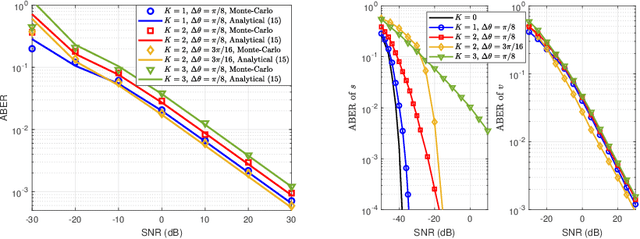
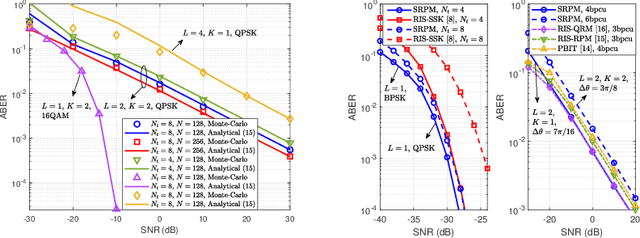
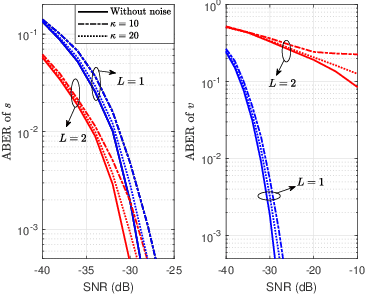
Abstract:To fully exploit the additional dimension brought by reconfigurable intelligent surface (RIS), it is recently suggested by information theory that modulating information upon RIS phases is able to send extra information with increased communication rate. In this paper, we propose a novel superimposed RIS-phase modulation (SRPM) scheme to transfer extra messages by superimposing information-bearing phase offsets to conventionally optimized RIS phases. The proposed SRPM is interpreted as a universal framework for RIS phase modulation. Theoretical union bound of the average bit error rate (ABER) of the proposed SRPM is also derived with the maximum likelihood (ML) detection. The diversity order is characterized as 0.5 for all parameter settings, which is useful for determining the optimal choice of the phase modulation parameters. Furthermore, we discover that doubling the number of either RIS reflecting elements or the transmit antennas is equivalent to a 3 dB increment in the transmit power for SRPM. Numerical results demonstrate the effectiveness of SRPM and reveal that it achieves reliable communication of more bits than existing schemes.
 Add to Chrome
Add to Chrome Add to Firefox
Add to Firefox Add to Edge
Add to Edge